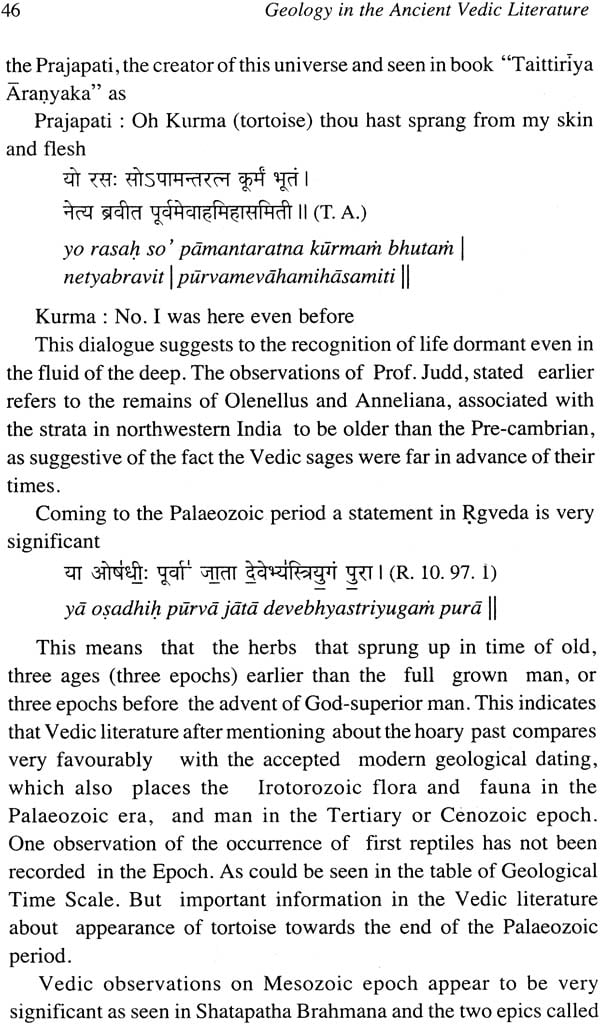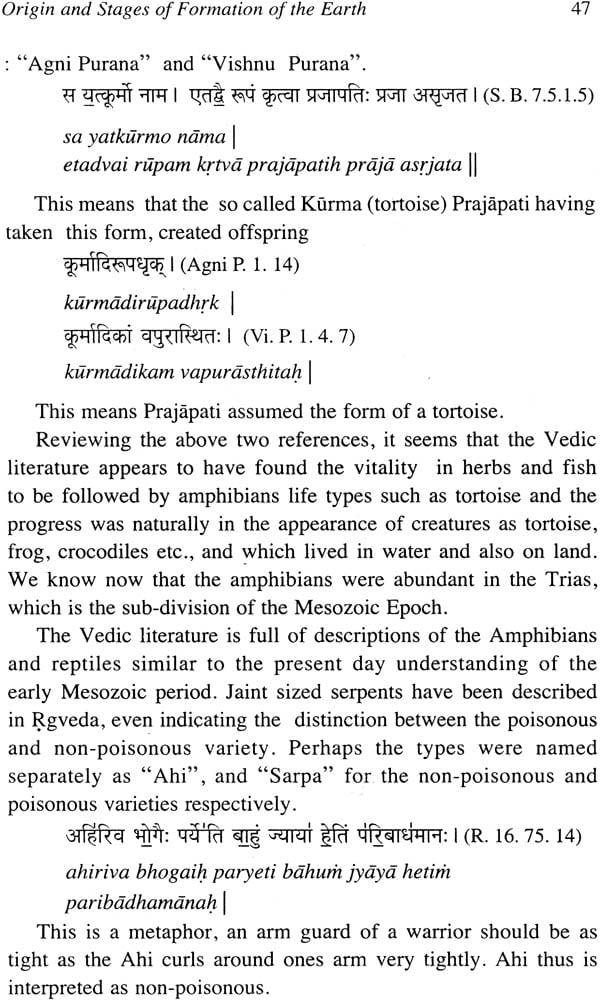
Geology in The Ancient Vedic Literature
Book Specification
| Item Code: | NAK921 |
| Author: | Dr.Y.S. Sahasrabuddhe |
| Publisher: | Bhandarkar Oriental Research Institute, Pune |
| Language: | Sanskrit Text With Transliteration and English Translation |
| Edition: | 2006 |
| Pages: | 112 |
| Cover: | Paperback |
| Other Details | 8.5 inch X 5.5 inch |
| Weight | 120 gm |
Book Description
Born on 2nd February, 1923, Dr. Sahasrabudhe got his M.Sc. Degree in Geology in 1948 from Ferguson College, Bombay University.
He then worked as a demonstrator, assisting the research project in Petrology and Chemical analysis of rocks, for the M. Sc. And Ph.D. thesis, Selected by the Union Service Public Commission for a gazatted cadre in Geological Survey of India, in 1949, and retired as Director of the Survey after 33 years meritorious service, in 1981, As part of the early career, he did systematic geological mapping, of about 4000 Sq. Kms., covering almost all rock formations in the country. Later he attended to various mineral/ore exploration projects acquiring specialization in explorations in Bauxite.
He examined all the bauxite occurrences in Maharashtra State, proving some of the deposits in the virgin areas of Saurashtra and kutch in the Gujarat State. His studies on the genesis of these deposits fetched him the Ph.D. degree, with a unique distinction of working without any recognized guide.
In 1965, he won another distinction of becoming Technical Secretary to the Deputy Director General, where he coordinated all the Mapping and Detail Mineral Exploration Project in the states of Maharashtra and Madhya Pradesh, right upto the submission of the final reports on them. In 1972 he was promoted to the post of director, Engineering Geology Division, in which capacity he guided the Geo-technical exploration on several medium and major irrigation and hydel projects in Maharashtra and Madhya Pradesh states for about nine years. He has a rare experience in examining three major earthquake episodes and submit comprehensive reports. They were the earthquake of dibrugarh, in Assam in 1951, the Anjar earthquake of Gujarat in 1956 and the Koyna earthquake in 1965.
Dr. Shasrabudhe, in spite of a heavy schedule of field and office work, kept a live interest in academical research. He is the fellow of the Maharashtra Academy of Science and Life Member of several National and international Scientific Institutions. He is the author of about 40 publication/papers presented at different national and international seminars etc.
He had the privilege to participate in the International Geological Congress, Sydney (Australia) in 1976 as an official delegate. He was the member of the working group of IGCP 129 and led three field excursions for the three international conferences, namely, The International Geological Congress, India (1964), International Symposium on the “Deccan Traps and Related Volcanic Provinces in other parts of the world”, held in Bombay, 1979, and the IGCP 129 session at Trivendrum (1979).
He was the chief (Indian Side) during the two Indo-Japanese joint studies on the Deccan Traps in India. He also represented the department on its few special committees, such as Committee for reservation of areas for iron and Manganese deposits for Public Sector, Tariff Commissions, etc.
He has been a recognized guide in the Nagpur University and was responsible for successfully guiding a few of his officers for Ph.D. in the Department.
After retirement, he was nominated as a Panel Member for the “Dam Safety Review Panel” in the world Bank-aided projects in Madhya Pradesh for 8 years. He also worked as a consultant to the prestigious project of konkan Railway Corporation, in areas of 85 tunnels and about 100 high level heavy duty bridges, etc.
| General | 1 | |
| 1 | Origin & structure of the universe | 13 |
| 2 | Origin & stages of the formation of earth | 14 |
| Nine stages of formation of the earth | 16 | |
| a | Phena (Foam | 17 |
| b | Mrt (claq) | 18 |
| c | Suskap (dryness) | 19 |
| d | Usha, (salinity) | 19 |
| e | Sikata (granulation) | 20 |
| f | Sankana (crystalline granite) | 21 |
| g | Asma (Compact granule) | 22 |
| h | Ayask and hirangana | 22 |
| i | Vegetation | 22 |
| Interior of the earth | 24 | |
| Earth and the atmosphere | 24 | |
| The Earth's movements | 27 | |
| Geomorphology of the earth | 28 | |
| Stratigraphy | 42 | |
| Azioc Group | 44 | |
| 3 | Applied aspects of geology | 51 |
| Surface water | 52 | |
| Ground Water | 55 | |
| Minerals, Ayurvedic system & medicines | 57 | |
| Earthquakes | 62 | |
| a) | Varahamihira and prediction of earthquakes | 68 |
| b) | Testing the validity of the parameters | 70 |
| Conclusions | 71 | |
| 4 | Age and practices of Vedic civilization | 73 |
| Plates | ||
| Spread of Tethys. N. Punjab | 80 | |
| Earthquake circles from Bruhatsamhits | 81 | |
| Table showing circlewise distribution of stars, their lords at the time of occurrence of earthquakes | 82 | |
| Table showing geographic regions of the four circles With effects of earthquakes in them | 83 | |
| Two-way plots of the earthquake episodes with their alternate parameters. | 84 | |
| Appendix-I | Original Vedic Sanskrit text | 85 |
| Appendix-II | Minerals and their Ayurvedic names | 94 |
| Appendix-III | List of diseases, present Ayurvedic medicines and minerals in their preparations. | 96 |







